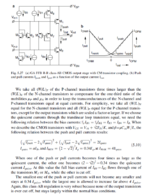wes_s01
Newbie
Hello,
I have been reading the book "Operational Amplifiers" by Johan Huijsing. A mosfet-based class AB output stage is described that has two translinear loops which keep each device at a minimum current when a large current occurs in the other.
Some equations are given, 5.3.7 and I am trying to derive them but am having difficulty getting the same solution.
I am beginning with one equation for each translinear loop and one for each feedback device:
Vgs1 + Vgs4 = Vgs7 + Vgs8
Vgs2 + Vgs3 = Vgs5 + Vgs6
I3 + I4 = 2IB
Am I going in the wrong direction here? Curious if anyone has gone through this algebra before and could lend a hand.
Thanks!
I have been reading the book "Operational Amplifiers" by Johan Huijsing. A mosfet-based class AB output stage is described that has two translinear loops which keep each device at a minimum current when a large current occurs in the other.
Some equations are given, 5.3.7 and I am trying to derive them but am having difficulty getting the same solution.
I am beginning with one equation for each translinear loop and one for each feedback device:
Vgs1 + Vgs4 = Vgs7 + Vgs8
Vgs2 + Vgs3 = Vgs5 + Vgs6
I3 + I4 = 2IB
Am I going in the wrong direction here? Curious if anyone has gone through this algebra before and could lend a hand.
Thanks!
